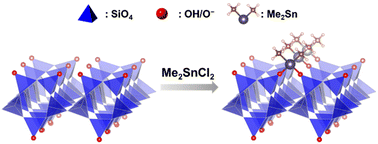Immobilization of isolated dimethyltin species on crystalline silicates through surface modification of layered octosilicate†
Abstract
Single metal atoms supported on silica are attractive catalysts, and precise control of the local environment around the metal species is essential. Crystalline silica is useful as an efficient support for the incorporation of well-defined metal sites. Dimethyltin species were regularly grafted onto the layer surfaces of layered octosilicate, a type of two-dimensional (2D) crystalline silica. Dimethyltin dichlorides react with the surface silanol (SiOH) groups of the silicate layers. The formation of Si–O–Sn bonds was confirmed by 29Si magic-angle spinning (MAS) NMR. X-ray absorption fine structure (XAFS) analysis showed the four-coordinated Sn species. These results suggested the presence of well-defined dipodal dimethyltin species on the layer surfaces. The degree of modification of the silanol groups with the dimethyltin groups increased with increasing amounts of dimethyltin dichloride; however, the maximum degree of modification was approximately 50%. This value was interpreted as an alternate modification of the octosilicate reaction sites with dimethyltin groups. These results demonstrate the potential for developing highly active single metal catalysts with a high density of regularly arranged active sites on high surface area supports.



 Please wait while we load your content...
Please wait while we load your content...